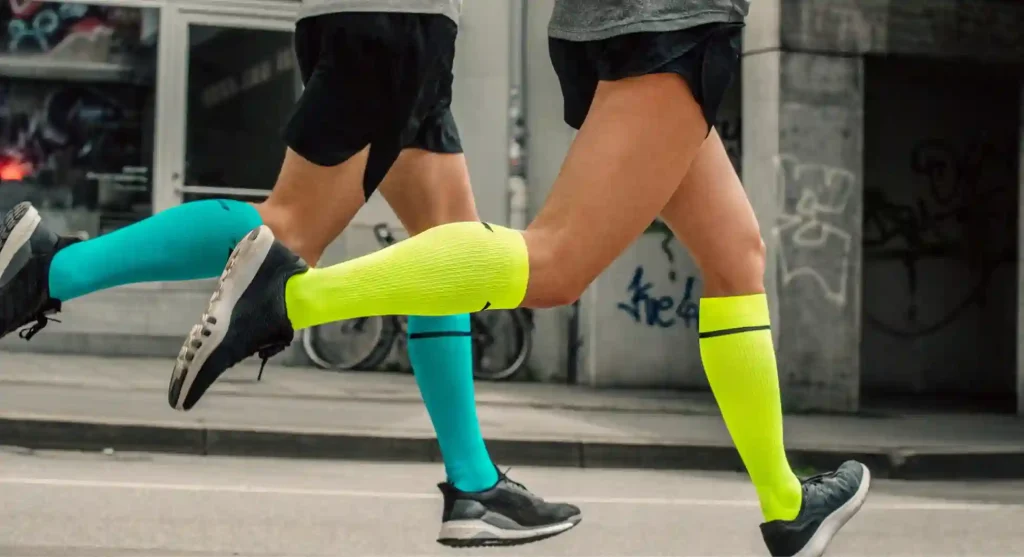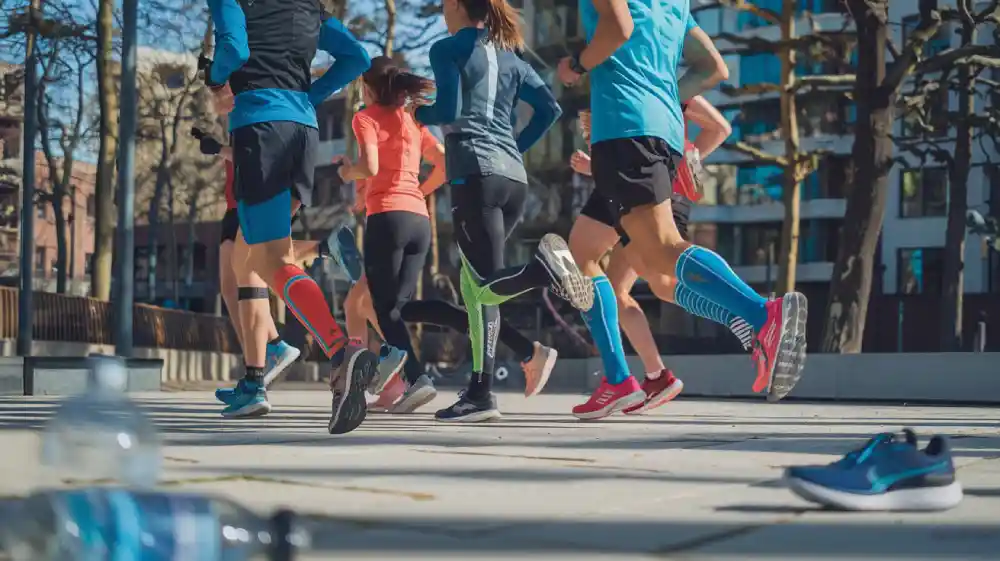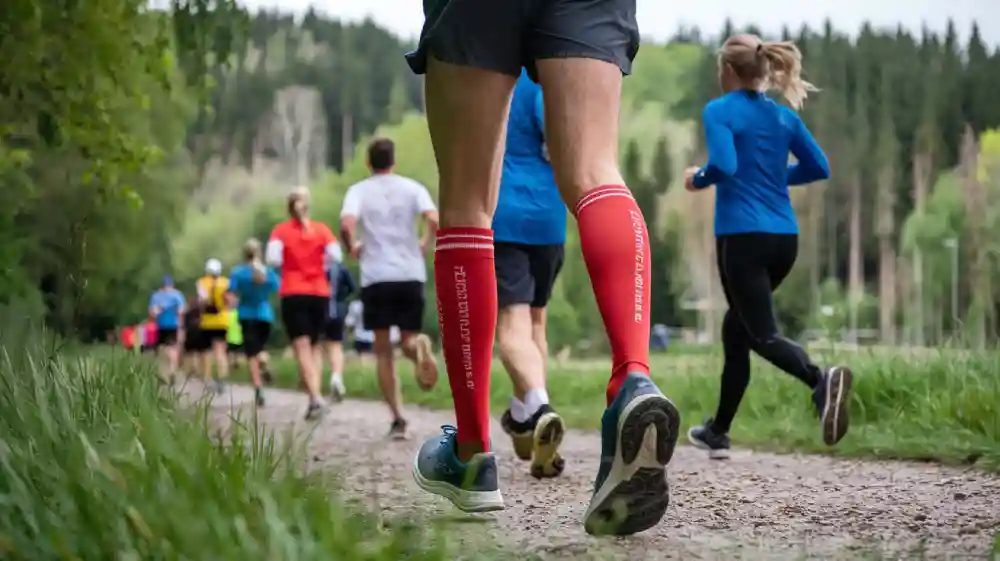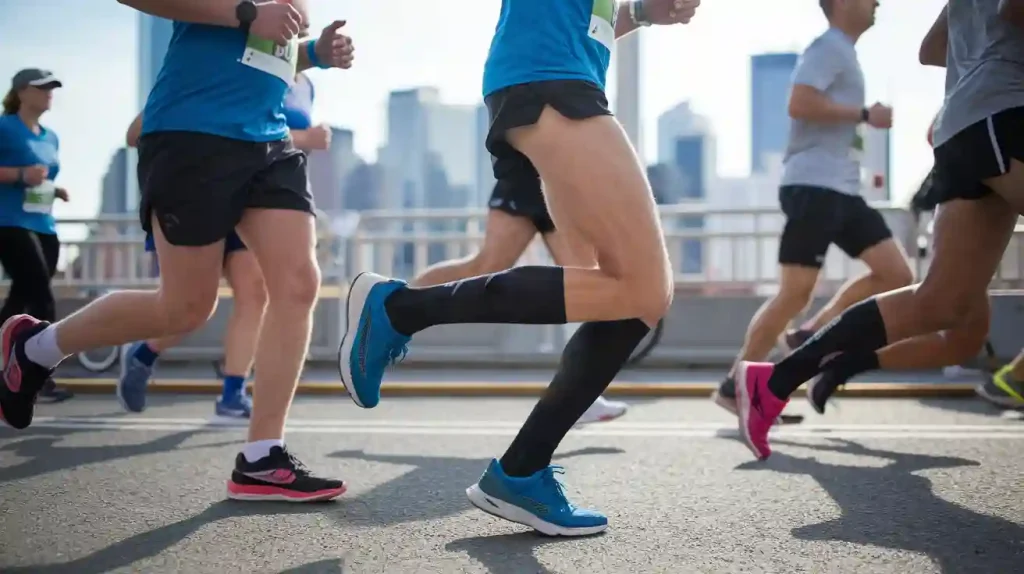
Compression socks are quickly becoming a staple for runners, offering real benefits like improved circulation, reduced muscle fatigue, and faster recovery. What started as a niche product is now a trend that athletes swear by—and brands are paying attention. From reducing post-run soreness to preventing injuries, these socks provide runners with performance enhancements that can’t be ignored. For retailers and manufacturers, this presents a unique opportunity to meet growing demand with custom solutions. If you’re looking to tap into a booming market, understanding why runners rely on compression socks is the first step. Here’s why this trend is more than just a fad—and how it can boost your business.
Understanding Compression Socks: What Makes Them Effective for Runners?
By applying graduated pressure to the calf muscles, compression socks enhance venous blood flow toward the heart—a mechanism clinically proven to accelerate circulation. This targeted compression doesn’t just reduce fatigue; it actively flushes metabolic waste products like lactic acid from tissues, addressing a key contributor to delayed-onset muscle soreness (DOMS). Simultaneously, improved oxygen delivery to muscles creates an environment optimized for both performance efficiency and accelerated recovery.
The key feature that sets compression socks apart for athletes is their ability to reduce swelling and the buildup of lactic acid, which often leads to soreness and delayed recovery. They’re engineered to provide just the right amount of pressure where it’s needed most, helping to prevent injuries and reduce recovery time between runs.
While scientific consensus supports the benefits of compression socks for recovery and injury prevention, research on performance enhancement remains inconclusive. Some studies indicate improved running economy and reduced lactate accumulation, while others show no significant impact on race times or physiological markers. These discrepancies likely stem from variations in sock design, compression levels, and individual biomechanics. Athletes should experiment with different products to determine personal efficacy.
Enhance Running Performance
Compression socks boost circulation by applying targeted pressure to the legs, improving the flow of oxygenated blood to muscles. This helps optimize performance by delivering nutrients more efficiently, reducing fatigue during intense activity, and speeding up the body’s natural recovery processes.
Additionally, they minimize muscle soreness both during and after runs. By stabilizing the muscles and reducing excessive vibration, these socks decrease the likelihood of discomfort, allowing runners to feel less drained after long or strenuous workouts.
Moreover, compression socks provide critical support in preventing injuries. They stabilize the calf and shin muscles, reducing the risk of common issues like shin splints and calf strains. This enhanced support enables runners to push their limits without worrying about overexertion or muscle strain.
In colder climates, compression socks provide an added layer of insulation, maintaining optimal muscle temperature and reducing the risk of cramps. Many designs now feature reflective elements, enhancing visibility during early morning or evening runs—a critical safety feature for urban or low-light environments. This blend of practicality and style positions compression socks as versatile gear for year-round use.

The Recovery Factor
Compression socks are a game-changer when it comes to speeding up post-run recovery. The targeted pressure they apply helps accelerate the removal of metabolic waste, such as lactic acid, from muscles. This aids in reducing soreness and helps runners feel less stiff after intense or long-duration exercise, allowing them to recover more quickly.
They also play a critical role in minimizing swelling and preventing fluid buildup in the legs, a common issue after long runs or races. The graduated pressure forces fluids back into the circulatory system, reducing the heavy, swollen feeling that many runners experience post-workout.
Runners swear by these socks after tough races or long training sessions. The benefits are clear: less muscle soreness, reduced swelling, and faster recovery. By incorporating compression into their post-run routine, athletes can get back to training sooner, pushing their performance to new heights with less downtime.
Injury Prevention
Compression socks are essential for reducing the risk of common injuries that often affect runners. By providing consistent pressure to key areas like the calves, they help stabilize muscles and prevent excessive movement that can lead to strains or overuse injuries. This is especially crucial for long-distance runners who put repeated stress on their muscles over extended periods.
They also play a significant role in preventing more serious conditions like deep vein thrombosis (DVT) and varicose veins. The gentle compression helps improve blood circulation, reducing the chances of blood clots forming in the legs—an important factor for athletes who spend hours training or traveling long distances.
Beyond muscles, these socks also provide critical support to joints, especially in the knees and ankles. By stabilizing the lower leg, they help runners avoid overexertion and reduce the strain on key muscle groups, allowing athletes to maintain peak performance without risking injury.

The Fashion Trend
Compression socks have become a must-have in sports fashion, blending performance with style. What started as a practical accessory is now a trend, with athletes and fitness enthusiasts wearing them as much for the look as for the benefits.
Brands are catching on, offering sleek designs and a wide range of colors to match any runner’s style. From simple, solid tones to bold patterns, there’s a compression sock for every preference, making it easy for athletes to express themselves.
As fashion and performance merge, runners are no longer settling for basic gear. Style has become a key factor in the appeal of compression socks, attracting a broader customer base and driving sales. The right design can turn these socks into a must-have accessory, not just a functional tool.
Who Benefits Most from Compression Socks?
Compression socks are useful for all types of runners, whether professional or casual. For elite athletes, wearing them during or before runs can enhance circulation and improve performance. Casual runners will find them most beneficial after a run, helping to reduce soreness and speed recovery.
These socks are particularly effective post-race, reducing swelling and muscle stiffness, making recovery faster and less painful. Wearing them immediately after running helps to flush out toxins and ease discomfort.
Beyond runners, diabetics, pregnant women, and people with poor circulation can also benefit. These socks improve blood flow, reduce swelling, and alleviate leg fatigue. They’re also helpful for those who spend long hours on their feet, like nurses or flight attendants.
While compression socks are widely beneficial, they are not suitable for everyone. Individuals with circulatory disorders, deep vein thrombosis (DVT), or severe skin sensitivities should avoid them unless prescribed by a healthcare provider. Pregnant women and those with peripheral artery disease should consult their doctors before use. Always prioritize medical guidance to ensure safe and effective usage.

How to Select the Right Compression Socks: A Guide for Runners and Retailers
When choosing compression socks, focus on compression level, fit, length, material, and specialized features.
For compression, a pressure of 20-30 mmHg is ideal for most runners, offering the right support for both performance and recovery. The material should be breathable and moisture-wicking, with options like nylon, merino wool, and polyester being the top choices for comfort and durability during runs.
Fit is crucial: Choose the right size based on ankle and calf measurements to avoid discomfort or restricted circulation. Over-the-knee styles provide extra support, especially for long runs or recovery periods.
Length Matters: Crew-length socks (6–8 inches) shield legs from debris and moisture, ideal for trail running or cold weather. No-show and ankle socks prioritize breathability and minimalism for warm climates but offer less protection in rugged terrain.
Material Selection: Avoid cotton, which retains sweat and increases blister risk. Opt for synthetic blends like polyester or nylon for durability and moisture-wicking properties, or merino wool for natural odor resistance and temperature regulation.
Specialized Features: Seamless designs reduce friction, while padded socks cushion high-impact zones. Trail-specific socks often include reinforced soles and grippy textures, ensuring stability on uneven ground.
Common mistakes include choosing the wrong compression level, selecting materials that don’t breathe well, or buying the wrong size, which can hinder performance and comfort. Ensuring proper fit and the right material is key to maximizing the benefits.
Expanding Market Opportunities: How to Position Compression Socks for Different Customer Segments
To tap into a broader market, don’t just focus on elite runners. Casual athletes and fitness enthusiasts are also increasingly turning to compression socks for their benefits. These individuals may not be training for a marathon, but they still prioritize comfort, recovery, and injury prevention in their fitness routines. By marketing to this segment, you can expand your reach and appeal to those seeking performance-enhancing gear for everyday workouts.
There are also untapped opportunities in niche markets. Diabetics use compression socks to improve circulation and reduce the risk of foot problems, while pregnant women often turn to them to relieve leg swelling. Additionally, people who experience poor circulation, such as those with sedentary jobs, can benefit from the enhanced support these socks provide. By targeting these groups, you can diversify your customer base and address their unique needs.
Seasonal trends also play a significant role in how compression socks are marketed. While they’re in high demand during peak running season, these socks can be marketed year-round by highlighting their recovery benefits, support during long flights, or relief for those who stand for extended periods. By positioning compression socks as a versatile product that serves both fitness and health needs, retailers can create a steady demand throughout the year.
Partnering with Manufacturers: How Custom Compression Socks Can Differentiate Your Brand
Working with a reliable manufacturer ensures that your custom compression socks meet the highest standards of quality. By controlling every step of production—from sourcing premium materials to rigorous quality checks—you guarantee consistency and performance. Adopting AQL standards in the inspection process ensures that each product meets both customer expectations and international quality requirements.
Custom socks offer flexibility in material selection, making it easy to tailor your product to the specific needs of your audience. Whether it’s breathable fabrics for athletes or antimicrobial materials for medical use, you can choose the right materials for each target group. Fabrics like nylon, spandex, and merino wool can be selected for optimal comfort and performance.
Compression levels can also be customized, allowing you to address a wide range of needs. For athletes, a 15-20 mmHg level is ideal for performance, while medical compression (30-40 mmHg) caters to recovery or circulation issues.
Custom designs and packaging offer further ways to set your brand apart. Tailor the colors, patterns, and logos to match your brand’s identity, and choose packaging that enhances the customer experience. This level of customization creates a unique product that stands out in a crowded market.
If your brand is looking for quality customized compression sock solutions, please choose Jiaxing Max Hosiery!
Conclusion: Why Now is the Best Time to Offer Compression Socks for Runners
Compression socks are more than a passing trend—they represent a fusion of science, functionality, and style. As demand grows across athletes, healthcare patients, and fashion-conscious consumers, brands can differentiate themselves by offering customized solutions that address specific needs. By prioritizing innovation, quality, and inclusivity, businesses can tap into this expanding market and solidify your position as leaders in athletic apparel.
Learn more about the customization details of running compression socks. Partner with a trusted manufacturer to create high-quality, functional products that elevate your brand and appeal to a growing market.
FAQs
Can I customize the design and packaging of my compression socks?
Yes, you can fully customize both the design and packaging of your compression socks. Design options include color, patterns, and logos that align with your brand image. Custom packaging, such as boxes or eco-friendly bags, can help enhance your brand’s visibility and create a better customer experience. Customizing both design and packaging allows you to stand out and deliver a cohesive product that resonates with your target market.
Are custom compression socks suitable for all customer segments?
Yes, custom compression socks can be marketed to a variety of customer segments. While runners and athletes are the obvious target, they are also beneficial for diabetics, pregnant women, and individuals with poor circulation. Additionally, compression socks are used by professionals who spend long hours on their feet, such as nurses and flight attendants. By offering different styles and compression levels, you can appeal to a wide range of markets beyond just athletes.
Can I offer custom compression socks for different seasons?
Yes, compression socks can be adapted for different seasons. Winter socks can be made with warmer materials, such as merino wool, to keep the legs comfortable and insulated. Summer versions can focus on breathability and moisture-wicking fabrics like Coolmax or polyester to keep legs cool and dry. By offering seasonally tailored products, you can tap into year-round demand and cater to customers’ needs throughout different weather conditions.
What are the benefits of custom packaging for compression socks?
Custom packaging elevates your product’s presentation and enhances your brand’s identity. It not only provides protection for the socks but also offers an opportunity to engage customers with your brand’s story and visual appeal. By using custom boxes, eco-friendly materials, or unique design features, you can improve customer experience and make your product stand out on retail shelves or online. Packaging also serves as an effective marketing tool to boost brand recognition.
What are the advantages of offering compression socks with specific health benefits?
Offering compression socks designed for specific health conditions (such as varicose veins, deep vein thrombosis (DVT) prevention, or swelling reduction) allows your brand to tap into the growing market for therapeutic wear. These socks provide targeted relief for customers who need support beyond sports or fitness, creating a niche market. By positioning your products as health-focused, you can attract a different demographic of customers, such as elderly individuals or those recovering from surgery.
